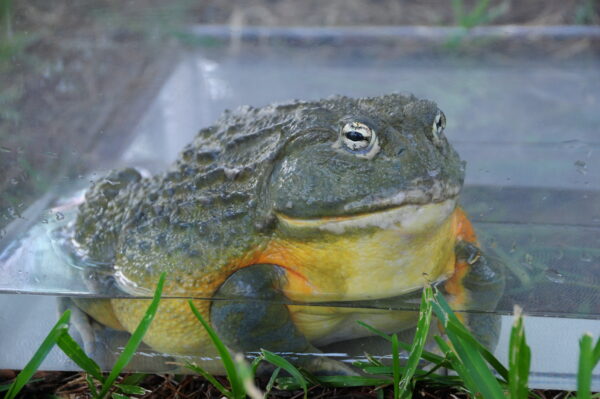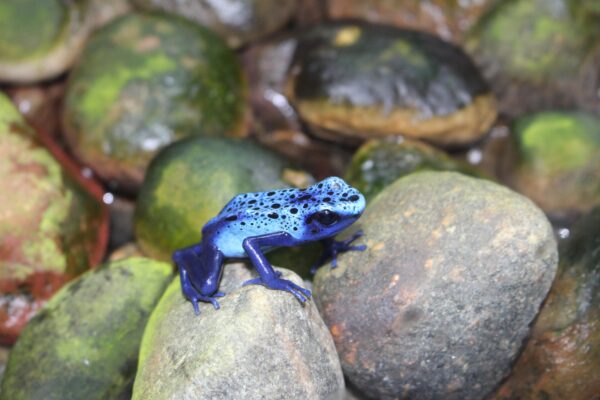RIBBIT!
That sound is a big unison hello from all the frogs at the Virginia Zoo! They want to welcome you to World Frog Day, which we’re celebrating Sunday, March 20 at the Zoo.
Did you know that . . .
. . . frogs are found on every continent except Antarctica?
. . . there are approximately 4,800 of species of frogs, with the most varieties appearing in rain forests?
. . . about 100 species of frogs are poisonous?
. . . toads are a kind of frog?
. . . not all frogs are green?
. . . frogs have been around for more than 200 million years?
At the Virginia Zoo, there are a number of species of frogs, which are amphibians. Recently, the world has lost more than 120 species of amphibians due to habitat loss, disease, over-collection, climate change, pesticides and pollution. It is a real possibility that frogs, toads, salamanders and newts may go extinct in the next few years. Read more here for ways you can help prevent this.
Learn about a few of the frogs at the Virginia Zoo:
Ornate horned frog This frog lives in the tropical and mountain rainforests of South America. A carnivore, it is a compulsive eater and will attempt to swallow anything that moves close to its wide mouth, such as insects, lizards and other frogs – even if it would suffocate in the process. It’s fat in appearance and has small“horns” above its eyes and a very wide mouth. It is bright green with reddish-brown oval spots over its back and a yellowish underbelly.
With their short legs and bumpy skin, they look a lot like toads, but they’re still frogs because they have teeth. If threatened by a larger animal (such as a human), they will sometimes jump towards their attacker and deliver a painful bite. These frogs are sometimes called“mouths with legs”because their mouths are so big.

African bullfrog One of the most adaptable amphibians on Earth, the African bullfrog can tolerate some of the harshest environments in Africa. They live in dry savannahs, open grasslands and low elevations. They eat nearly any animal they can overpower and will fit into their huge mouths.
Other prey may include invertebrates, other species of frogs, reptiles, small mammals and even small birds. To capture a meal, it drops its lower jaw with force, causing the tongue to flip over and out, seizing the prey. Males are olive in color with yellow/orange throats. Females are olive/light brown with cream/white throats. Males can weigh more than two pounds, while females are about half the size. They are unique in this manner, in that among frogs, as in most amphibians, females are usually larger than males. African bullfrogs can live up to 40 years.
North American bullfrog This frog is native to southern and eastern North America and has been introduced to other parts of North, Central and South America, Western Europe and parts of Asia. They must live in water, so they’re usually found near some source of water, such as a lake, pond, river or bog. They prefer warm, still, shallow water. They eat snakes, worms, insects, crustaceans, tadpoles and eggs of fish, frogs, insects or salamanders. There have been a few cases reported of bullfrogs eating bats.
North American bullfrogs are the largest true frog in North America, weighing up to a pound. Their color varies from brownish to shades of green, often with spots or blotches of a darker color on their back. The hind feet are fully webbed. Bullfrogs prefer warm weather and hibernate during the winter.
The sex of the adult bullfrog can be easily determined by examining the size of the tympanum (external ear) relative to that of the eye. The tympanum is a round circle located on the side of the head near the eye, and in males it is much larger than the eye. In females, it is as large as or smaller than the eye.

Poison dart frog Native to the rainforests of Central and South America, poison dart frogs come in many vibrant colors and patterns, and more than 100 species. It is their skin that contains the frog’s poison. Their beautiful colors warn potential predators that they are poisonous and therefore serve as protection. They get their name from Amerindian tribes’ use of their toxic secretions to poison the tips of blow darts.
Not all dart frogs are deadly, and only three are dangerous to humans. The most deadly is the golden poison arrow frog. Its poison can kill many small animals or even humans. After they have been in captivity for a while, they lose their toxicity. Scientists think they gain their toxicity from a specific arthropod and other insects that they eat. They eat crickets in the Zoo.
Poison dart frogs range from less than an inch to two and a half inches in body length. In the wild, they eat mostly spiders and small insects such as ants and termites, which they find on the forest floor using their excellent vision. They capture prey by using their long, sticky tongues.
While Sunday is World Frog Day, the Zoo will be celebrating all things green. You might see a rhino rat snake, an Aldabra tortoise or a chameleon – who’s only green when he feels like it.
Come out and see how cool it is to be green at the Virginia Zoo!

source: National Aquarium